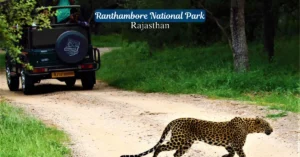
Top 5 Wildlife And National Parks in India: Best Places for Safaris and Nature Lovers
- 55
- 0
- 0
India is a paradise for wildlife lovers, offering a diverse range of national parks and wildlife sanctuaries. From dense forests to vast grasslands, the country is home to some of the most stunning landscapes and rare animal species. The thrill of spotting majestic creatures in their natural habitat makes wildlife safaris an unforgettable experience.
Visiting these parks allows you to witness rich biodiversity, from big cats to vibrant bird species. Safaris provide an opportunity to connect with nature, escape city life, and experience the wild up close. Whether you seek adventure or tranquillity, these destinations offer both. With strict conservation efforts, these parks also play a crucial role in protecting endangered species. Exploring them not only brings excitement but also supports wildlife conservation, making your journey both thrilling and meaningful.
Top 5 Wildlife And National Parks in India: Best Places for Safaris and Nature Lovers
India’s national parks are amazing places where you can watch tigers, elephants, rhinos, and many other incredible animals in their natural home. Let’s look at the five best parks you should visit if you love wildlife and want to go on incredible safaris.
Jim Corbett National Park, Uttarakhand

Jim Corbett is India’s oldest national park, started in 1936. It’s in the beautiful state of Uttarakhand, about 6 hours from Delhi by car. The park is most famous for its Bengal tigers – there are over 230 of them living here! But tigers aren’t the only stars. You’ll also find wild elephants, deer, leopards, and more than 600 types of birds.
Best time to visit: November to June How to get there: Drive from Delhi (6 hours) or take a train to Ramnagar Safari. Options:
- Jeep safaris (morning and evening)
- Elephant safaris (limited areas)
- Canter safaris (bigger vehicles for groups)
Where to stay: The park has many hotels and resorts for different budgets. You can pick from simple guest houses to fancy jungle lodges. Many places are in Dhikala, the main area of the park.
Tips for visitors:
- Book your safari at least 2-3 months before
- Wear natural-coloured clothes (green, brown, or beige)
- Early morning safaris give you the best chance to see animals
- Carry a good camera and binoculars
- Take warm clothes in winter (November-February)
Ranthambore National Park, Rajasthan

Ranthambore is probably India’s most well-known tiger reserve. It’s special because you can see tigers walking around old ruins and ancient temples. The park used to be a hunting ground for kings, but now it’s a safe home for about 70 tigers.
The best time to visit is October to June How to get there:
- Nearest airport: Jaipur (180 km)
- Nearest railway station: Sawai Madhopur (10 km)
What you can see:
- Bengal tigers
- Leopards
- Sloth bears
- Different types of deer
- Crocodiles
- Many birds
- Historic ruins and the impressive Ranthambore Fort
Safari details:
- Two safari times: 6:30 AM and 2:30 PM
- Each safari is about 3 hours
- Choose from jeeps (6 people) or canters (20 people)
- The park has 10 zones – some are better for tiger spotting than others
Where to stay: There are many hotels near the park. You can find basic rooms for Rs. 2,000 per night or luxury resorts for Rs. 20,000 or more.
Kaziranga National Park, Assam

Kaziranga is special because it’s home to two-thirds of the world’s one-horned rhinoceros. This UNESCO World Heritage site lies along the mighty Brahmaputra River. The park’s grasslands and forests are perfect for rhinos, elephants, and tigers.
The best time to visit is November to April Getting there:
- Nearest airport: Jorhat (97 km)
- Nearest city: Guwahati (230 km)
What makes it special:
- Largest number of one-horned rhinos in the world
- High number of tigers
- Wild water buffalos
- Different types of deer
- River dolphins in the Brahmaputra
- Many rare birds
Safari types:
- Jeep safaris
- Elephant safaris (best for seeing rhinos up close)
- Boat safaris on the Brahmaputra
Important tips:
- The park closes during monsoon (May to October)
- Elephant safaris need to be booked well in advance
- Morning safaris are best for bird-watching
- Evening safaris are good for seeing animals at water holes
Bandhavgarh National Park, Madhya Pradesh

Bandhavgarh is famous for having the highest number of tigers in any Indian park. The park is smaller than others, which makes it easier to spot tigers. It also has beautiful hills, old caves, and grasslands.
The best time to visit is October to June How to reach:
- Nearest airport: Jabalpur (164 km)
- The nearest railway station is Umaria (35 km)
What you can see:
- High chance of tiger sightings
- Leopards
- Different types of deer
- Many bird species
- Ancient caves with drawings
- Historic fort
Safari information:
- Morning safari: 6:00 AM to 10:30 AM
- Evening safari: 2:30 PM to 6:30 PM
- Both jeep and elephant safaris are available
- The park has three main zones
Where to stay: Many good hotels and resorts are near the park gates. Prices start from Rs. 3,000 per night.
Sundarbans National Park, West Bengal
The Sundarbans is different from other parks because it’s the world’s largest mangrove forest. It’s where rivers meet the sea, creating a special place for unique animals, including tigers that can swim in salt water!
The best time to visit is December to February How to get there:
- From Kolkata by road and boat
- Nearest airport: Kolkata (140 km)
What makes it unique:
- Swimming tigers
- Mangrove forests
- River dolphins
- Crocodiles
- Many types of water birds
- Beautiful boat rides
Safari details:
- Most safaris are by boat
- Tours last from 1 to 5 days
- You stay on the boat or in forest rest houses
- Guides are a just as the area is complex
Important things to know
- No walking safaris are allowed
- Weather can change quickly
- Carry seasickness medicine
- Book through approved tour operators
General Tips for All Park Visits
Booking and Planning:
- Book safaris and hotels 2-3 months before
- Check park closing dates (many close during monsoon)
- Try to stay for at least 2-3 safaris
- Carry cash, as ATMs might be far
What to Pack:
- Natural coloured clothes
- Hat and sunglasses
- Sunscreen
- Water bottle
- Light jacket or sweater
- Good walking shoes
- Camera and extra batteries
- Basic medicines
During Safari:
- Listen to your guide
- Stay quiet during safari
- Don’t get out from the vehicle
- Keep your phone on silent
- Don’t feed any animals
- Follow all park rules
Best Times:
- Early morning safaris usually show more animals
- Winter months are best for most parks
- Avoid monsoon season (July-September)
Photography Tips:
- Carry a camera with good zoom
- Keep extra memory cards
- Use silent mode on cameras
- Ask guides for the best photo spots
- Be patient while taking pictures
Each of these parks shows a different side of India’s amazing wildlife. They all work hard to protect animals and their homes. When you visit, you not only see wonderful animals but also help in saving them. Remember to be a responsible visitor and follow all park rules. This helps keep these beautiful places safe for future visitors and, most importantly, for the animals who live there.
Whether you want to see tigers, rhinos, elephants, or rare birds, these five parks will give you amazing wildlife moments. Just remember to plan, be patient during safaris, and respect the animals and their home.
FAQs
Which are the best national parks for safaris in India?
India offers thrilling safaris at Jim Corbett, Ranthambore, Kanha, Kaziranga, and Bandipur. These parks are famous for tigers, elephants, rhinos, and diverse wildlife, making them perfect for nature lovers and adventure seekers.
What is the best time to visit national parks in India?
The best time for wildlife safaris is October to June, as most parks remain open. Winters (November–February) offer clear sightings, while summer (March–June) increases the chances of spotting animals near water sources.
What types of safaris are available in Indian national parks?
Most parks offer jeep safaris, canter safaris, and elephant safaris. Jeep safaris provide close encounters, canter safaris accommodate groups, and elephant safaris (available in select parks) allow unique perspectives of the forest.
Are permits required for safaris in Indian national parks?
Yes, all national parks require an entry permit, which can be booked online or at the park’s office. Booking is recommended, especially during peak seasons, as permits are limited per safari zone.
What precautions should visitors take during a safari?
Follow park guidelines: stay inside the vehicle, avoid loud noises, never feed animals, and carry essentials like water, cameras, and binoculars. Always respect wildlife and listen to the guide for a safe experience.
Also Read:
References:
https://en.wikipedia.org/wiki/List_of_national_parks_of_India
https://en.wikipedia.org/wiki/Kaziranga_National_Park
Disclaimer: Wildlife safaris and national park visits involve inherent risks. Always follow park guidelines, respect wildlife, and prioritize safety. Information provided is for general awareness; verify local regulations and conditions before travelling. Responsible tourism supports conservation and ecosystem preservation.
Related post


